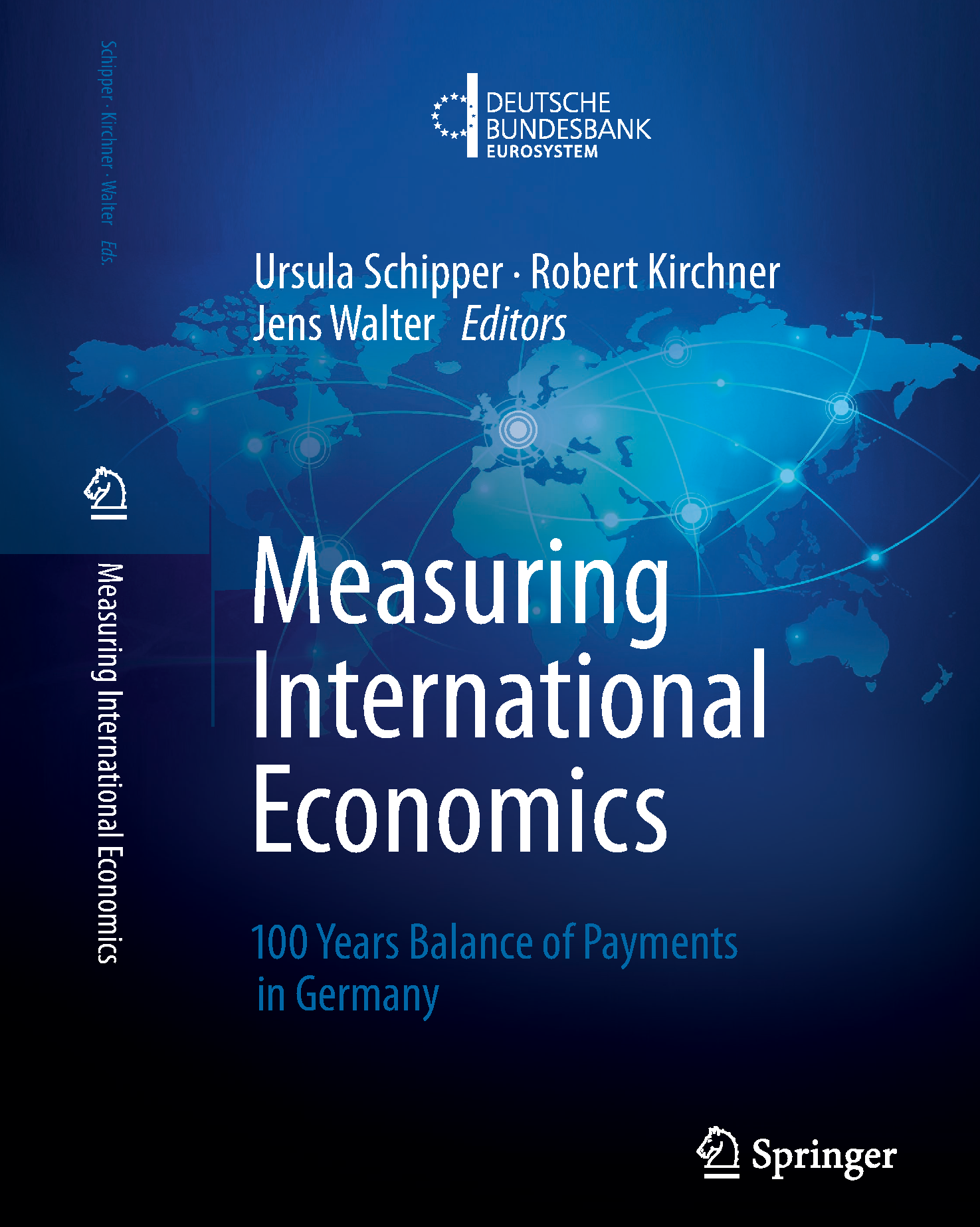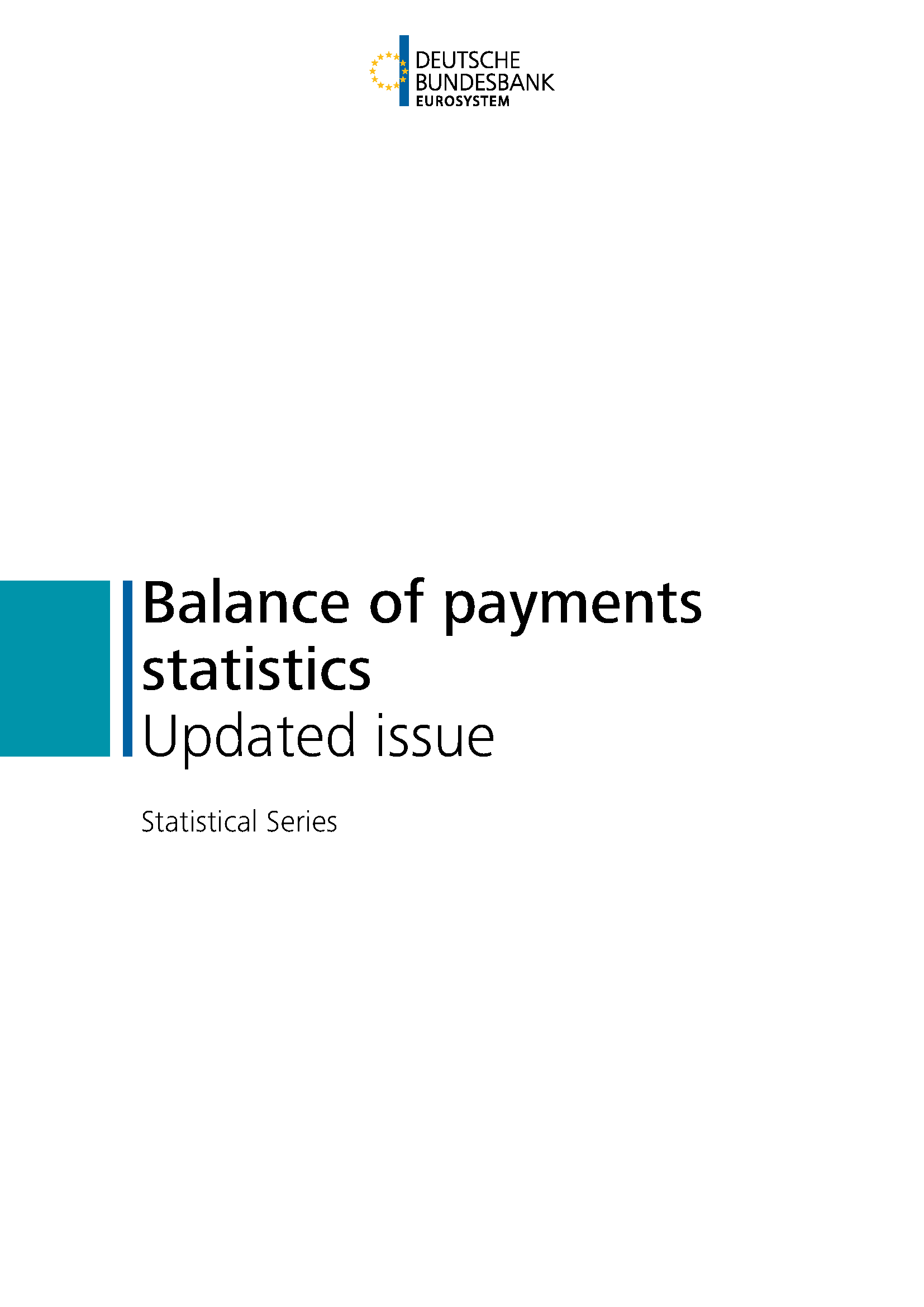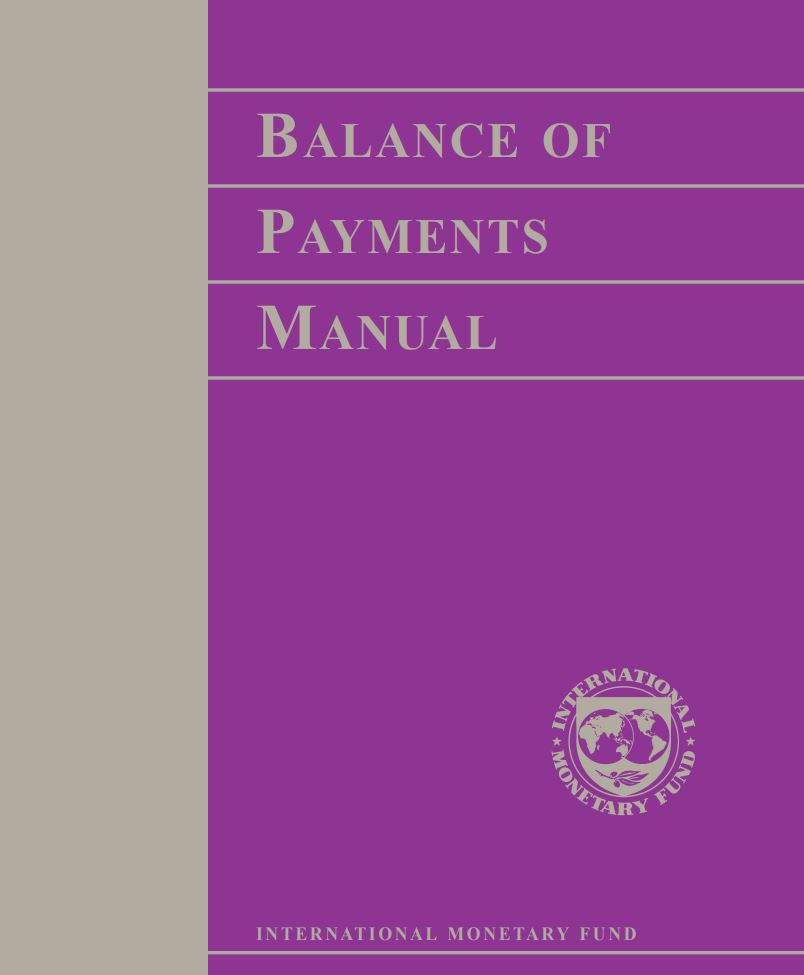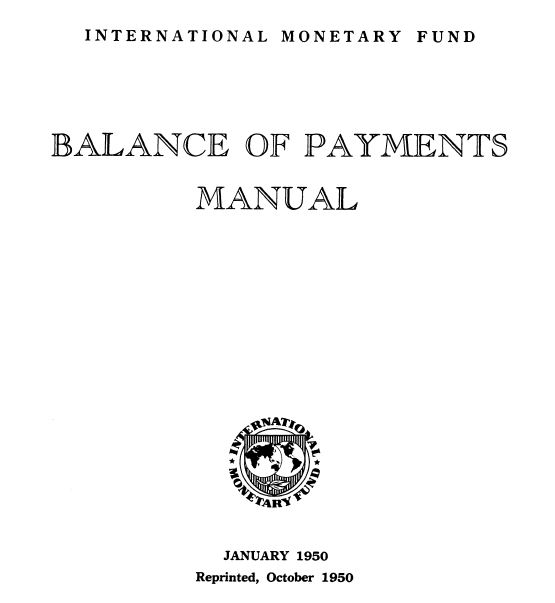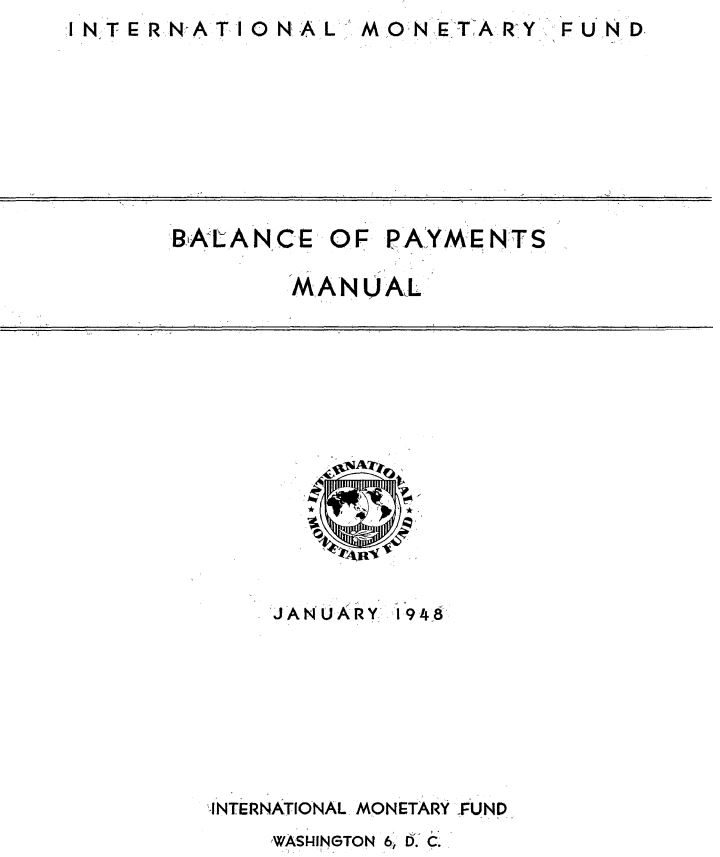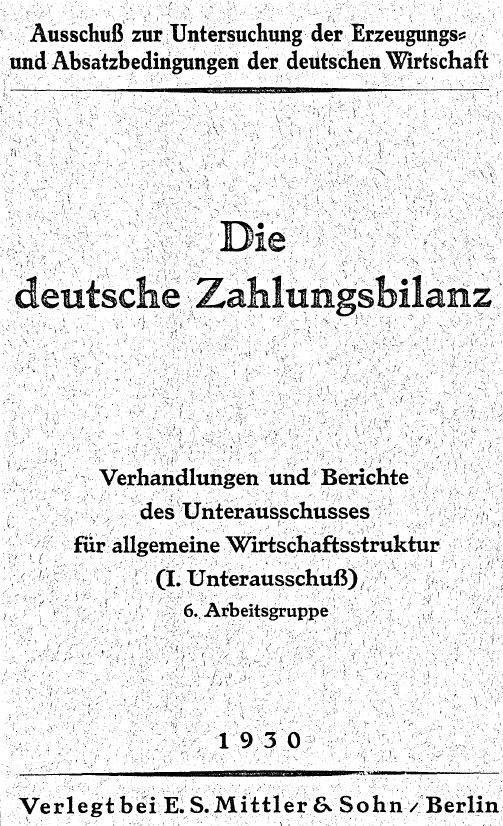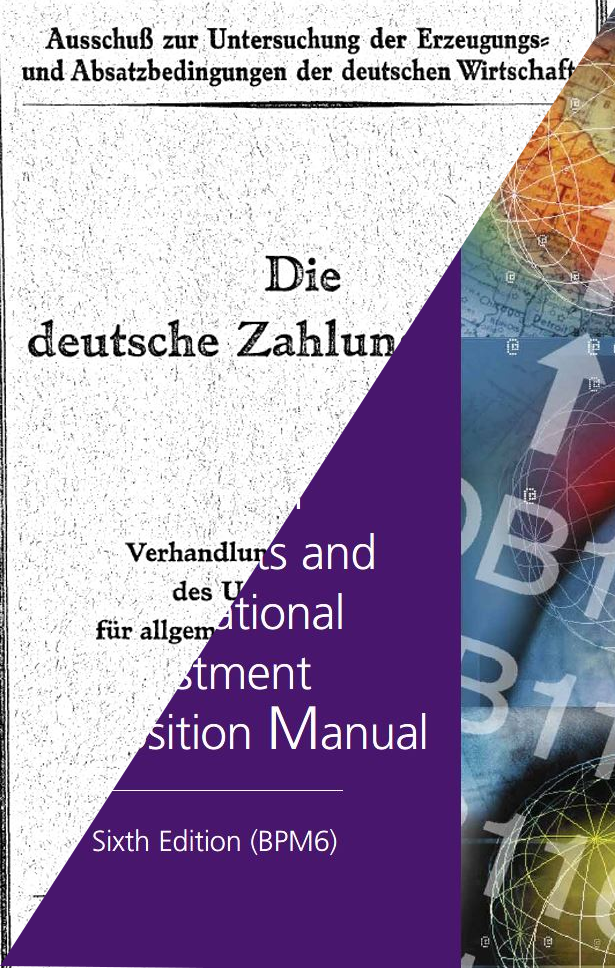100 years of the German balance of payments A review from 1924 to 2024
- Completion
- Outlook: Balance of payments manual – edition 7
- Special statistical publications
- Publication of results
- Submission of reports
- Balance of payments manual – edition 6
- Balance of payments manual – edition 5
- Explanatory notes to the table: Anniversary: 100 years of balance of payments
- Balance of Payments Manual – Edition 4
- Further development of the statistical collection system II
- Further development of the statistical collection system I
- Statistical Supplement 3
- Statistical reports on the balance of payments
- The Balance of Payments Manual – Edition 3
- The Balance of Payments Manual – Edition 2
- The Balance of Payments Manual 1st Edition
- Further Development of Concepts
- The first international framework for the balance of payments
- How the official German balance of payments came into being
- “Memorandum on Balance of Payments and foreign trade balances”
- Resolution of the League of Nations
- The first German balance of payments
In 2024, we will take the anniversary as an opportunity to reflect on the past every now and then. Travel back in time with us to see where the 1924 and 2024 balance of payments have a lot in common and where they differ (in some cases significantly).
In addition, an upcoming Monthly Reports will include an article exploring the past hundred years of the balance of payments.
Completion
And as in flight, the 100th year of the German balance of payments also passed. We hope that with this series we have been able to give you an interesting insight into the many different aspects of the balance of payments from 1922 to the present day.
On the occasion of the 100th birthday of the German balance of payments, an anniversary volume was also created in 2024 in which standard setters and users reflect their view of the balance of payments in general and the German contribution to development in particular. After the technical process has been completed, this publication will be published as an open source project here in the course of 2025. With the cover and the content, we can give you a taste of this interesting work.
We are looking forward to the exciting developments that will certainly continue in the external sector in the coming years.
Download
Outlook: Balance of payments manual – edition 7
Since 2020, the international statistical community has been working on the revision of the balance of payments manual. This has four main topics:
- Stronger integration between balance of payments and international investment position
In the 6th edition, the international investment position was established as a central statistic for external economic analyses. The two statistics are now even better integrated. This will also be reflected in the title of the manual. - Globalisation
The revision of the 6th edition is also a sign of increasing globalisation. In the 7th edition, the role of multinational enterprises is highlighted in particular. - Digitalisation
Progressive digitalisation is having a strong impact on an increasing number of sectors in the economy. The manual takes this into account and explains how digitalisation can be reflected in the mapping of transactions in statistics. - Islamic Finance
The terms and phenomena of the external sector have so far been strongly oriented towards the Western financial system. The new edition will also discuss how Islamic finance instruments fit into the framework of external
economic statistics.
The International Monetary Fund is planning to publish the new balance of payments manual as of April 2025. The countries of the European Union have already decided to compile the external economic statistics from 2029 onwards in accordance with the new requirements.
External link
imf.org
Special statistical publications
In addition to the regular publication of statistical results, particularly interesting sub-aspects were published once a year in special statistical publications. There were three special publications in external statistics:
- Balance of payments by region
- Technological services
- Direct investment
Over time, the special publications have been translated into other forms of publication. The special publication on direct investment became the statistical series on direct investment. The balance of payments by region has been replaced by regional results in Excel format. This allows, for example, the monthly publication of the current account against any other country. There is no 1:1 replacement for information on technological services. However, with the extensive monthly publication of all services, more information is available here, too, than was possible in the special publication.
Download
Publication of results
The Bundesbank traditionally published statistical results in the annexe to the Monthly Report. As the results for the various Bundesbank statistics are so extensive that the Monthly Report would be too thick, most of the re-sults were separated out into so-called supplements to the Monthly Report. These printed publications could be ordered for each interest additional to the Monthly Report. The printing of the supplements was discontinued at the end of 2018. The information was then only made available as a pdf file.
In April 2020, the supplements were replaced by the so-called statistical series. Even if the statistical series ap-pear to be very similar to the supplements at first glance, there is a decisive difference. The results in the statis-tical series are no longer made available on a reference date. Instead, each table can have its own publication date. This means that the latest information is always available in the statistical series. These current series of subjects can be found on the respective statistics pages on the right under “Data”.
In addition to this issue, regular (usually monthly) “frozen” versions are available on the Bundesbank’s website under Publications in order to make it easier to quote in scientific papers.
Current statistical series
Frozen statistical series
bundesbank.de
Submission of reports
The requirements for the granularity of the balance of payments have always been rising. It is therefore essential for statistics to constantly work on improving the technical infrastructure in order to be able to process the growing data volumes efficiently. This also includes, but not only, the submission of reports.
The transmission of data has been possible electronically for a long time. Before the age of Internet, physical disks were exchanged. With the establishment of the Internet, direct transmission was also possible. In addition, for a very long time, however, it was always possible to submit reports on a paper form. This option was also used extensively. The new Foreign Trade and Payments Regulation 2013 made electronic submission mandatory. Since then, the mountains of paper have been history in external statistics.
The submission platform, the General Reporting Portal Statistics (AMS), is currently being designed from the ground up to make submission even more convenient for reporters.
Balance of payments manual – edition 6
In the 90s and early 2000s, there were a number of economic crises (including Mexico 1994, Asia 1997, Argentina 2002), which were partly caused by unsustainable foreign debt. These crises highlighted the enormous importance of the international investment position for economic policy analysis. The concepts for measuring the external economy responded radically to this. While the 5th edition of the Balance of Payments Manual describes the international investment position for the first time in a few pages, the 6th edition places the international investment position at the centre of the analysis, while the balance of payments mainly explains the changes in the international investment position. This is also illustrated by the fact that the accounting conventions in the financial account have been changed in such a way that the sign indicates the change in stock. The international investment position was also included in the name of the manual (Balance of Payments and International Investment Position Manual). It was also discussed whether this was a completely new concept and whether the counting of the manuals should start again at #1. This is obviously not the case.
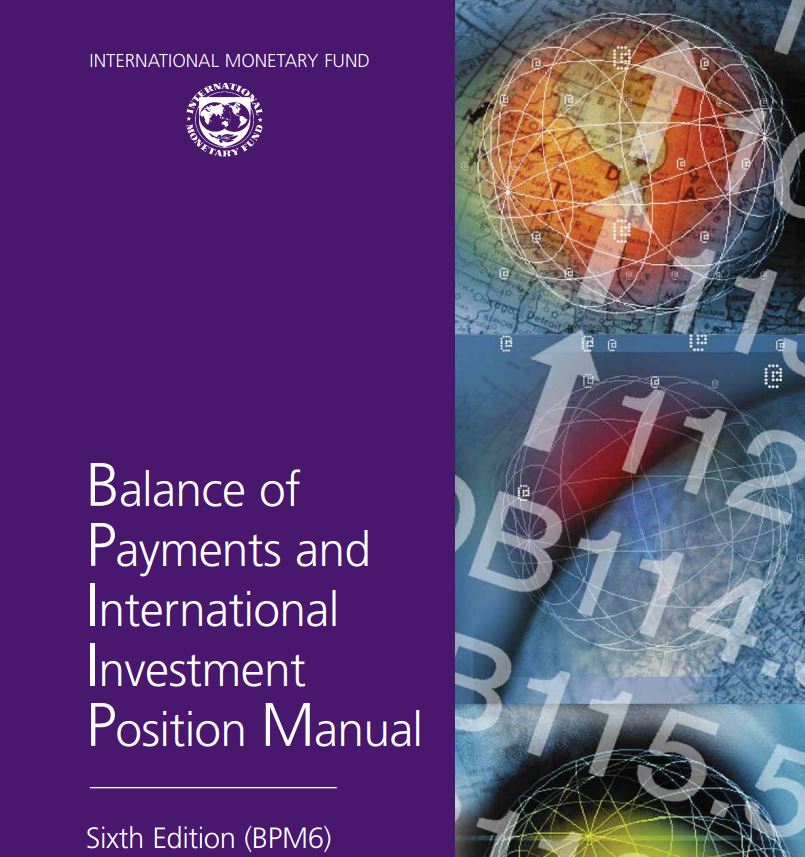
The progress made in IT has also led to a further sharp increase in trade in services. The UN responded to this in 2002 with its own handbook on international trade in services, which was updated in 2010. The measurement of international trade in services, based on the balance of payments, has thus been further developed. Services statistics, which have been proposed here, have been compiled in part by the Bundesbank since 2024.
Internal link
Changes in the methodology and classifications of the balance of payments and the international investment position
Article from the Monthly Report June 2014
External links
Sixth Edition of the IMF's Balance of Payments and International Investment Position Manual (BPM6)
imf.org
unstats.un.org
Balance of payments manual – edition 5
Even at the beginning of the conceptual considerations on the sensible measurement of external economic linkages, it was clear that it was important not only to measure transactions but also to measure stocks. However, the challenges for measuring stocks reliably were probably considered too high, while stocks were still very low, especially at the beginning. This is why it has been limited to measuring transactions in the balance of payments. This should change in the 5th edition of the Balance of Payments Manual. Here, the International Monetary Fund has now conceptually described the measurement of external position in the form of the international investment position.
In addition, economic interconnectedness had changed since the 4th edition of the Balance of Payments Manual. On the one hand, trade in services has risen sharply and is now presented in a more differentiated manner. On the other hand, liberalisation in the international capital markets has led to its substantial strengthening of interconnectedness and new products, the statistical treatment of which is now also described.
Download
in German only
External link
imf.org
Explanatory notes to the table: Anniversary: 100 years of balance of payments
When producing statistical results, a high value is given that the results are comparable over time. The basic concepts of the balance of payments remained very stable over the entire period presented. However, the focus of the presentation has changed significantly over time. It is therefore not trivial to present the results of 1924 and 2023 in a meaningful and uniform scheme. It would have been easier to translate the results at the current edge into the previous presentations. However, as a current user of the table knows the current presentation, we consider the usefulness of the table to be higher in the current presentation, even if only a rough allocation of the results was possible in the early years.
In the compilation of the results of the balance of payments since 1924 there are a number of serious limitations when comparing the results over time:
- Economic area: Over time, the area of Germany has changed several times. The statistics map the external transactions of the respective country.
- Currency: Before 1949, the results are presented in Reichsmark. Results from 1949 onwards are presented in euro. The results were converted into DM with the official exchange rate (1 euro = 1.95583 DM).
- Concepts: The balance of payments is currently being compiled in accordance with the requirements of the 6th edition of the Balance of Payments Manual.
From 1991 to the current end, the results largely meet these requirements.
From 1971 to 1990, the implementation of the 6th edition (2014) carried out rough recalculations where possible.
Before 1971, only the sign of the financial account was switched. No further adjustments were made to modified concepts.
Download
Balance of Payments Manual – Edition 4
In 1973, the system of fixed exchange rates of Bretton Woods, which had determined the monetary order for decades, was de facto dissolved. This had a strong impact on international financial markets and their interconnectedness. These massive changes led to a revision of the balance of payments manual in 1977. The analytical role of the balance of payments in financial transactions has grown sharply. The balance of payments had to answer many new analytical questions.
The authors of the balance of payments manual have taken this into account by developing the balance of payments into an external accounting system, thus providing users with many different analytical modules. The most obvious changes concern the financial account. The introduction of functional categories (direct investment, portfolio investment, other investment) responds to the changes in the financial market environment in order to better analyse them.
After more than 50 years of continuous development in the balance of payments, the 4th edition of the Balance of Payments Manual represents the greatest revolution in the concepts of the balance of payments. Any statistics that are relevant need to evolve further in order to still provide reliable and helpful information when the framework conditions change. The balance of payments demonstrated this ability impressively with the 4th edition of the balance of payments manual.
Internal link
2013_10_14_bretton_woods
External link
imf.org
Further development of the statistical collection system II
When efficiently compiling a macroeconomic models such as the balance of payments, it is continuously evaluated whether the current mix of sources generates the statistical results well and cost-efficiently. Where possible, existing information is used. In some cases, however, this information is also the basis for statistical modelling of the results. For example, the change in inventory data is often used as an approximation of the balance of transactions over this period. In addition, advanced statistical methods sometimes make it possible to dispense with certain information.
This optimisation is carried out continuously in the statistical production process. These changes are most obvious to outsiders if statistical reports can be omitted altogether. In the 1990s, the forms Z 2 (foreign account report (receipts)) and Z 3 (foreign account report (outputs)) were omitted. Since then, the information can be obtained from a combination of the Bundesbank’s external position, the banks’ external positions and the enterprises’ external positions.
Internal links
Further development of the statistical collection system I
When efficiently compiling a macroeconomic models such as the balance of payments, it is continuously evaluated whether the current mix of sources generates the statistical results well and cost-efficiently. Where possible, existing information is used. In some cases, however, this information is also the basis for statistical modelling of the results. For example, the change in inventory data is often used as an approximation of the balance of transactions over this period. In addition, advanced statistical methods sometimes make it possible to dispense with certain information.
This optimisation is carried out continuously in the statistical production process. These changes are most obvious to outsiders if statistical reports can be omitted altogether. In 1974 and 1984, there were adjustments to the External Economic Regulation, in which the survey forms Z 6 (past-due foreign claims), Z 7 (advance payments for exports) and Z 9 (travel agency reporting) were discontinued. Since then, the information can be obtained from other sources.
Statistical Supplement 3
The Bundesbank has published the Monthly Report since its inception. Extensive statistical results were also published with each monthly report. As these exceed the scope of the Monthly Report, so-called “Statistical supplements to the Bundesbank’s Monthly Reports” have been established. The results of the balance of payments were published in Supplement 3. The oldest copy is available in electronic form from June 1968 (in German only).
The supplements were published in April 2020 by the so-called “Statistical Series” that are available as a PDF document only, but otherwise remained virtually unchanged. In future, this classic publication format will be accompanied by more contemporary publication formats.
Download
Statistical reports on the balance of payments
The compilation of large macroeconomic statistics such as the balance of payments is always a puzzle. Which sources are available and which gaps still need to be filled? Especially in the early days of the balance of payments, each compilation of the statistics was more like independent research work.
After the end of World War 2, it was not possible to simply hold foreign currency in Germany. It was necessary to apply for the foreign exchange required for foreign transactions (foreign exchange management). This was an excellent source of measuring cross-border transactions when drawing up the balance of payments statistics. Over time, however, foreign exchange management has become more and more relaxed, meaning that more and more indirect sources and estimates had to be used to compile the statistics.
The year 1961 is a milestone for the preparation of the balance of payments statistics. This year, the Foreign Trade and Payments Regulation with reporting requirements for the balance of payments was adopted. It stipulates that both holdings and payments with non-residents must be reported directly to the Bundesbank. The balance of payments has been given its own collection tool. This has significantly stabilised the process of creating data, which is an important basis for producing high-quality figures comparable over time. Although the collection system is constantly being adapted to the changing world, it was created with so much foresight at that time that the basic system still exists today.
External link
in German only
bgbl.de
The Balance of Payments Manual – Edition 3
Eleven years after the 2nd edition, the IMF revised the balance of payments manual again. The change has two main priorities:
First, the principles of the balance of payments are presented in more detail. The handbook thus shifts the focus of the handbook from a mere description of statistical requirements to an introduction to the external statistics itself. Even though this introduction will continue to be expanded in the next editions, the handbook is still not a textbook on external statistics, but primarily a reference book for experts.
Second, small changes were made to the tables in order to make the balance of payments results more comparable with other economic statistics that were only developed after the 2nd World War. This objective, too, will always accompany the development of the forthcoming editions of the manuals. Thus, the autonomous balance of payments is continually being adapted to (new) statistics in order to further promote economic policy analyses.
External link
imf.org
The Balance of Payments Manual – Edition 2
The data for the individual countries were very heterogeneous. Compiling comparable country results for the balance of payments yearbook was very difficult. The findings from this work have led to a further revision of the balance of payments manual after just two years.
In addition to the main balance of payments table, additional tables have been added from which the main table can be derived. The IMF wanted to use the more detailed information to gain a better understanding of the differences and thus to better assess how comparable the data between countries are.
For government debt, a very detailed table was introduced, which contained the stock at the beginning and end of the period, as well as the reasons for the changes in stock. This scheme will be further developed into a fully integrated international investment position by the 7th edition.
In addition to these measures to improve comparability, there was also a major conceptual change. Undistributed profits have now been taken into account in the balance of payments in such a way that they are notoriously distributed and, at the same time, reinvested in the enterprise. This is still recorded today under “Reinvested earnings”.
External link
imf.org
The Balance of Payments Manual 1st Edition
After the end of World War 2, the United Nations took over the tasks of the League of Nations. The task of setting standards and publishing balance of payments was entrusted to the newly established International Monetary Fund (IMF). To this day, a key task of the IMF is to provide financial assistance to countries with serious balance of payments problems.
The 1st edition of the Balance of Payments Manual is fundamentally based on the developments of the League of Nations. A provisional form of the manual was adopted at a specialist conference in September 1947 with representatives from around 30 countries and international organisations. The structure is very similar to the League of Nations’ “Letter of Requirements”. However, a major innovation is that, in addition to extensive tables, the conceptual foundations of the balance of payments are presented centrally at the very beginning.
External link
imf.org
Further Development of Concepts
The concepts of the balance of payments have been continuously refined. For this purpose, a subcommittee was set up at the League of Nations in 1938, but it did not take up its work as a result of the outbreak of World War 2. It was convened again in 1945 and the members sent out a relatively short report as early as December 1945. Although the report is short, it should determine the evolution of the balance of payments over the next 30 years. The recommendation to rename the term “balance of payments” to “International Transaction Account” (unfortunately?) not implemented.
Extermal link
The first international framework for the balance of payments
The League of Nations used to send empty tables along with explanatory notes to countries on a regular basis in order to compile the results of the national balances of payments. The notes were around 12 pages long and were intended to make it as easy as possible to compare the results reported by the individual countries. This could therefore be considered the first international framework for the balance of payments. In many ways, the procedure was already very similar to the International Monetary Fund’s current conceptual requirements:
- Imports were to be recorded at cost, insurance and freight (c.i.f.) values, i.e. as valued at the border of the exporting country. The effects on the transport account were already explained. The c.i.f. valuation of imports was to undergo a critical review in the new edition of the Balance of Payments Manual but would remain unchanged until further notice.
- In the goods account, the necessary adjustments to foreign trade, which are still carried out in the same way today, were explained.
- The services listed already overlapped very closely with today’s services account – with the exception of IT services.
- The effects of migration on the balance of payments were dealt with extensively. These effects have been treated differently since 2009 (no transaction).
- The financial account distinguished between short and long-term transactions. It did not focus on today’s functional categories. However, back then, it was already specified that, for repayments, a distinction was to be made between payments of interest and payments of principal, and that fluctuations in value were not part of the balance of payments.
United Nations Archives at Geneva
archives.ungeneva.org
How the official German balance of payments came into being
On 15 July 1926, a working group in Germany was tasked with setting up a balance of payments, in keeping with the resolution of the League of Nations. In 1930, the working group published its results, starting with the 1924 reporting year. It largely applied the League of Nations schema. In some areas, the breakdowns were expanded to accommodate features idiosyncratic to Germany without jeopardising comparability with other countries. This is still standard practice today.
The current standards seek to ensure comparability by already including extensions to the “core balance of payments” as possible additional components. At that time, however, Germany chose its own approach to the treatment of banknotes, as the working group regarded banknotes as being closer in nature to loans than to (monetary) gold. This interpretation ended up prevailing internationally. Today, banknotes and short-term loans are reported together in the balance of payments (under the item “currency and deposits”).
Download
“Memorandum on Balance of Payments and foreign trade balances”
Further to the resolution of 1922, the League of Nations sent governments a series of empty tables, including instructions for completing them, and requested that these be filled out and returned.
We regard these instructions as the first international recommendation for compiling balance of payments statistics, even though very few countries initially followed these instructions but instead sent statistics compiled based on national systems that were in place. The League of Nations converted these submissions insofar as it was possible into the appropriate formats.
In 1924, the first report was published with statistics for 13 countries. Germany makes its first appearance in these reports in 1926 with statistics as of 1924.
United Nations Archives at Geneva
archives.ungeneva.org
archives.ungeneva.org
Resolution of the League of Nations
The phrase “Balance of Payments” was already used in the 14th century.
Sir James Steuart used it 1767 probably for the first time close to its modern sense.
In the 19th century, Great Britain and the United States of America made the first attempts to compile a balance of payments statistics. After the Great War the economic order changed dramatically and it lead to economic upheavals between countries. Therefore, the League of Nations ordered in its 3rd Assembly at 28th September 1922 the collection and publication of national balance of payments statistics.
“It hopes that the study of various questions connected with the stabilisation of currencies, and in particular that of the foreign trade balance and balance of payment of various States, which is an essential element of the problem, will be actively pressed forward so as to lead to the publication of reports which will throw light on this question, which is one of urgent importance.”
Resolution of the Third Assembly, 1922
League of Nations
This was the starting point for the systematic international development of concepts and methods for balance of payments statistics.
United Nations Archives at Geneva
archives.ungeneva.org
The first German balance of payments
The first comprehensive balance of payments for Germany was drawn up in 1924. The high reparation payments Germany was obliged to make after the end of the First World War led to distortions in the international economic exchange. This made it necessary to analyse other aspects of the international economic exchange besides the trade in goods.
